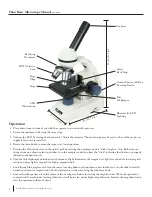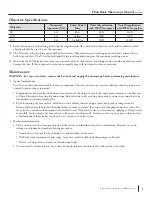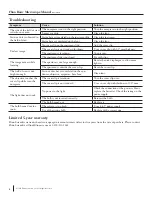
Flinn Basic Microscope Manual
continued
2
Operation
1. Place microscope in front of you with the eyepiece in a comfortable position.
2. Secure the specimen slide using the stage clips.
3. Turn on the LED by turning the rheostat dial. Adjust the intensity. The microscope may be used with or without a power
supply if batteries are installed.
4. Rotate the focus knobs to move the stage to its lowest position.
5. Position the 4X objective lens in the optical path by rotating the nosepiece until it “clicks” in place. Note: Each time you
change from one objective lens to another, turn the nosepiece until you hear the “click” indicating that the lens is properly
indexed in the optical path.
6. Turn the disk diaphragm until the desired amount of light illuminates the sample. Less light is required for lower magnifi-
cation and more light is required for higher magnification.
7. Look through the eyepiece and turn the coarse focusing knobs until specimen comes into focus. Scan the slide to located
desired specimen for magnification. Make adjustments to the focus using the fine focus knob.
8. Ensure that the specimen is in the center of the viewing area before increasing the magnification. When the specimen is
centered and focused under low magnification, it will be in view under higher magnification. Increase the magnification to
view the specimen with more detail.
© 2016 Flinn Scientific, Inc. All Rights Reserved.
Revolving
Nosepiece
DIN Objective
Lens
Eyepiece
LED
Illumination
Disc
Diaphragm
Stage
Clips
Coaxial Course and Fine
Focusing Knobs
Safety
Rack Stop
Rheostat for LED
Lighting
Stage
12.5 cm (5 in)
19 cm (7.5 in)
28 cm (11.5 in)


















